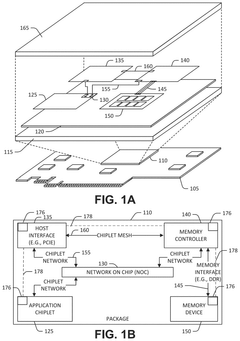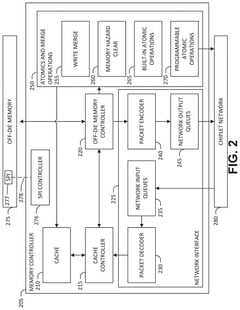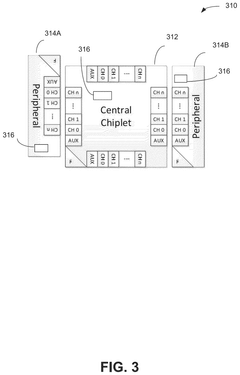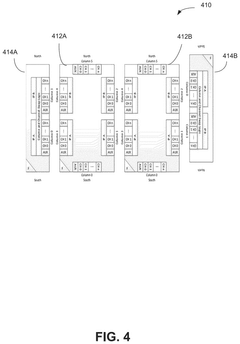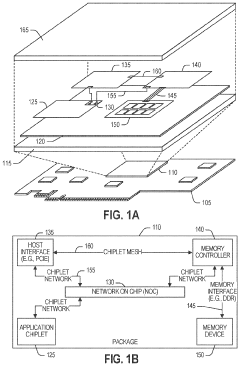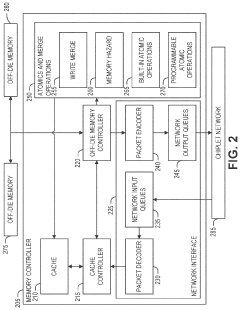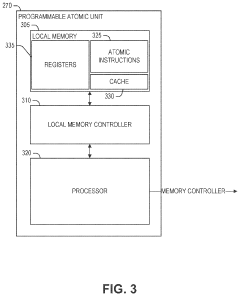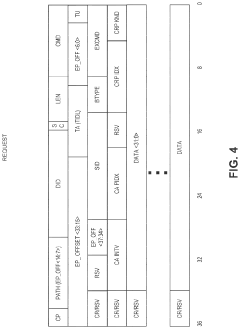How to Ensure Chiplet-Based Solutions Meet Regulatory Standards?
JUL 16, 20259 MIN READ
Generate Your Research Report Instantly with AI Agent
Patsnap Eureka helps you evaluate technical feasibility & market potential.
Chiplet Regulatory Landscape and Objectives
The chiplet-based design approach has emerged as a revolutionary paradigm in semiconductor manufacturing, offering enhanced flexibility, scalability, and cost-effectiveness. However, as this technology gains traction, ensuring compliance with regulatory standards becomes increasingly crucial. The regulatory landscape for chiplet-based solutions is complex and multifaceted, encompassing various aspects of design, manufacturing, and performance.
One of the primary objectives in this domain is to establish a comprehensive framework that addresses the unique challenges posed by chiplet integration. This includes developing standardized protocols for inter-chiplet communication, thermal management, and power distribution. Regulatory bodies such as the IEEE and JEDEC are actively working on creating industry-wide standards to facilitate seamless integration and interoperability of chiplets from different vendors.
Another key focus area is ensuring the reliability and security of chiplet-based systems. As these solutions often involve the integration of components from multiple sources, there is an increased need for robust verification and validation processes. Regulatory standards are being developed to address potential vulnerabilities in the interconnects between chiplets and to establish guidelines for secure data transmission within the system.
The environmental impact of chiplet-based solutions is also a significant consideration in the regulatory landscape. With the growing emphasis on sustainability in the tech industry, regulators are pushing for standards that promote energy efficiency and reduce electronic waste. This includes guidelines for the use of eco-friendly materials in chiplet packaging and the development of recyclable or reusable chiplet components.
Electromagnetic compatibility (EMC) and interference (EMI) regulations are being adapted to address the unique challenges presented by chiplet-based designs. The close proximity of multiple chiplets and the high-speed interconnects between them can potentially lead to increased electromagnetic emissions. Regulatory bodies are working on updating existing EMC/EMI standards to ensure that chiplet-based solutions do not cause interference with other electronic devices.
Intellectual property (IP) protection is another critical aspect of the chiplet regulatory landscape. As chiplet-based designs often involve the integration of IP from multiple sources, there is a need for clear guidelines on IP licensing, protection, and fair use. Regulatory frameworks are being developed to address these concerns and to promote innovation while safeguarding the interests of IP owners.
The overarching goal of these regulatory efforts is to create a standardized ecosystem that fosters innovation, ensures interoperability, and maintains the highest levels of quality and reliability in chiplet-based solutions. By establishing clear guidelines and standards, regulators aim to accelerate the adoption of chiplet technology across various industries while mitigating potential risks and challenges.
One of the primary objectives in this domain is to establish a comprehensive framework that addresses the unique challenges posed by chiplet integration. This includes developing standardized protocols for inter-chiplet communication, thermal management, and power distribution. Regulatory bodies such as the IEEE and JEDEC are actively working on creating industry-wide standards to facilitate seamless integration and interoperability of chiplets from different vendors.
Another key focus area is ensuring the reliability and security of chiplet-based systems. As these solutions often involve the integration of components from multiple sources, there is an increased need for robust verification and validation processes. Regulatory standards are being developed to address potential vulnerabilities in the interconnects between chiplets and to establish guidelines for secure data transmission within the system.
The environmental impact of chiplet-based solutions is also a significant consideration in the regulatory landscape. With the growing emphasis on sustainability in the tech industry, regulators are pushing for standards that promote energy efficiency and reduce electronic waste. This includes guidelines for the use of eco-friendly materials in chiplet packaging and the development of recyclable or reusable chiplet components.
Electromagnetic compatibility (EMC) and interference (EMI) regulations are being adapted to address the unique challenges presented by chiplet-based designs. The close proximity of multiple chiplets and the high-speed interconnects between them can potentially lead to increased electromagnetic emissions. Regulatory bodies are working on updating existing EMC/EMI standards to ensure that chiplet-based solutions do not cause interference with other electronic devices.
Intellectual property (IP) protection is another critical aspect of the chiplet regulatory landscape. As chiplet-based designs often involve the integration of IP from multiple sources, there is a need for clear guidelines on IP licensing, protection, and fair use. Regulatory frameworks are being developed to address these concerns and to promote innovation while safeguarding the interests of IP owners.
The overarching goal of these regulatory efforts is to create a standardized ecosystem that fosters innovation, ensures interoperability, and maintains the highest levels of quality and reliability in chiplet-based solutions. By establishing clear guidelines and standards, regulators aim to accelerate the adoption of chiplet technology across various industries while mitigating potential risks and challenges.
Market Demand for Compliant Chiplet Solutions
The market demand for compliant chiplet-based solutions is experiencing significant growth as the semiconductor industry shifts towards more modular and flexible chip designs. This trend is driven by the need for improved performance, reduced costs, and enhanced scalability in various applications, including data centers, artificial intelligence, and high-performance computing.
As regulatory standards become increasingly stringent, particularly in areas such as data privacy, security, and energy efficiency, there is a growing demand for chiplet solutions that can meet these requirements while maintaining their performance advantages. Companies across industries are seeking compliant chiplet-based solutions to ensure their products adhere to regulatory standards without compromising on innovation or time-to-market.
The financial services sector, for instance, requires chiplet solutions that comply with strict data protection regulations while delivering the high-performance computing capabilities needed for complex financial modeling and risk analysis. Similarly, the healthcare industry demands compliant chiplet solutions for medical devices and imaging systems that must adhere to stringent patient data protection and device safety standards.
In the automotive sector, the transition towards autonomous vehicles and advanced driver assistance systems (ADAS) has created a substantial market for chiplet solutions that meet automotive safety standards such as ISO 26262. These solutions must provide the necessary computing power for real-time decision-making while ensuring compliance with safety-critical regulations.
The telecommunications industry, particularly with the rollout of 5G networks, requires chiplet-based solutions that comply with electromagnetic compatibility (EMC) standards and energy efficiency regulations. As network infrastructure becomes more complex, the demand for modular, compliant chiplet designs that can be easily upgraded and maintained is increasing.
Cloud service providers and data center operators are also driving demand for compliant chiplet solutions. These customers require high-performance, energy-efficient chips that meet data protection regulations such as GDPR and CCPA, as well as environmental standards for reducing carbon footprints.
The market for compliant chiplet solutions is further bolstered by government initiatives and regulations aimed at promoting domestic semiconductor production and ensuring supply chain security. This has led to increased investment in chiplet technologies that can meet both regulatory and national security requirements.
As the Internet of Things (IoT) continues to expand, there is a growing need for chiplet solutions that comply with various standards related to device interoperability, security, and power consumption. This demand spans across consumer electronics, smart home devices, and industrial IoT applications, each with its own set of regulatory challenges.
As regulatory standards become increasingly stringent, particularly in areas such as data privacy, security, and energy efficiency, there is a growing demand for chiplet solutions that can meet these requirements while maintaining their performance advantages. Companies across industries are seeking compliant chiplet-based solutions to ensure their products adhere to regulatory standards without compromising on innovation or time-to-market.
The financial services sector, for instance, requires chiplet solutions that comply with strict data protection regulations while delivering the high-performance computing capabilities needed for complex financial modeling and risk analysis. Similarly, the healthcare industry demands compliant chiplet solutions for medical devices and imaging systems that must adhere to stringent patient data protection and device safety standards.
In the automotive sector, the transition towards autonomous vehicles and advanced driver assistance systems (ADAS) has created a substantial market for chiplet solutions that meet automotive safety standards such as ISO 26262. These solutions must provide the necessary computing power for real-time decision-making while ensuring compliance with safety-critical regulations.
The telecommunications industry, particularly with the rollout of 5G networks, requires chiplet-based solutions that comply with electromagnetic compatibility (EMC) standards and energy efficiency regulations. As network infrastructure becomes more complex, the demand for modular, compliant chiplet designs that can be easily upgraded and maintained is increasing.
Cloud service providers and data center operators are also driving demand for compliant chiplet solutions. These customers require high-performance, energy-efficient chips that meet data protection regulations such as GDPR and CCPA, as well as environmental standards for reducing carbon footprints.
The market for compliant chiplet solutions is further bolstered by government initiatives and regulations aimed at promoting domestic semiconductor production and ensuring supply chain security. This has led to increased investment in chiplet technologies that can meet both regulatory and national security requirements.
As the Internet of Things (IoT) continues to expand, there is a growing need for chiplet solutions that comply with various standards related to device interoperability, security, and power consumption. This demand spans across consumer electronics, smart home devices, and industrial IoT applications, each with its own set of regulatory challenges.
Regulatory Challenges in Chiplet-Based Designs
The regulatory landscape for chiplet-based solutions presents a complex array of challenges that designers and manufacturers must navigate. As chiplets become increasingly prevalent in semiconductor design, ensuring compliance with various regulatory standards becomes paramount. One of the primary challenges lies in the diverse nature of chiplet components, which may originate from different manufacturers and potentially different countries, each with its own regulatory requirements.
Electromagnetic compatibility (EMC) regulations pose a significant hurdle for chiplet-based designs. The interconnections between chiplets can create unintended electromagnetic emissions, potentially interfering with other electronic devices. Designers must carefully consider EMC standards such as FCC Part 15 in the United States or CISPR 22 in Europe when integrating multiple chiplets into a single package.
Thermal management is another critical regulatory concern. As chiplets allow for higher density integration, managing heat dissipation becomes more challenging. Regulatory bodies impose strict thermal limits to ensure device safety and reliability. Designers must adhere to standards like UL 60950 or IEC 62368, which specify temperature thresholds for electronic equipment.
Power consumption regulations also present challenges for chiplet-based solutions. With the push for energy efficiency in electronic devices, standards such as Energy Star in the US or the EcoDesign Directive in the EU set stringent power consumption limits. Chiplet designers must optimize power distribution and management across multiple dies to meet these requirements.
Security and data protection regulations add another layer of complexity. With chiplets potentially handling sensitive data, compliance with standards like GDPR in Europe or CCPA in California becomes crucial. Implementing secure interfaces between chiplets and ensuring data integrity throughout the system requires careful consideration of these regulatory frameworks.
Reliability standards pose unique challenges for chiplet-based designs. Regulations such as ISO 26262 for automotive applications or DO-254 for avionics demand rigorous testing and validation procedures. The modular nature of chiplets introduces new failure modes that must be addressed to meet these stringent reliability requirements.
Environmental regulations, including RoHS and REACH, impact the materials and manufacturing processes used in chiplet production. Ensuring compliance across multiple chiplets from different sources requires comprehensive supply chain management and material traceability.
Lastly, export control regulations like ITAR in the United States or the EU Dual-Use Regulation can affect the global distribution and collaboration in chiplet-based designs. Navigating these complex international regulations requires careful consideration of the origin and destination of chiplet components and technologies.
Electromagnetic compatibility (EMC) regulations pose a significant hurdle for chiplet-based designs. The interconnections between chiplets can create unintended electromagnetic emissions, potentially interfering with other electronic devices. Designers must carefully consider EMC standards such as FCC Part 15 in the United States or CISPR 22 in Europe when integrating multiple chiplets into a single package.
Thermal management is another critical regulatory concern. As chiplets allow for higher density integration, managing heat dissipation becomes more challenging. Regulatory bodies impose strict thermal limits to ensure device safety and reliability. Designers must adhere to standards like UL 60950 or IEC 62368, which specify temperature thresholds for electronic equipment.
Power consumption regulations also present challenges for chiplet-based solutions. With the push for energy efficiency in electronic devices, standards such as Energy Star in the US or the EcoDesign Directive in the EU set stringent power consumption limits. Chiplet designers must optimize power distribution and management across multiple dies to meet these requirements.
Security and data protection regulations add another layer of complexity. With chiplets potentially handling sensitive data, compliance with standards like GDPR in Europe or CCPA in California becomes crucial. Implementing secure interfaces between chiplets and ensuring data integrity throughout the system requires careful consideration of these regulatory frameworks.
Reliability standards pose unique challenges for chiplet-based designs. Regulations such as ISO 26262 for automotive applications or DO-254 for avionics demand rigorous testing and validation procedures. The modular nature of chiplets introduces new failure modes that must be addressed to meet these stringent reliability requirements.
Environmental regulations, including RoHS and REACH, impact the materials and manufacturing processes used in chiplet production. Ensuring compliance across multiple chiplets from different sources requires comprehensive supply chain management and material traceability.
Lastly, export control regulations like ITAR in the United States or the EU Dual-Use Regulation can affect the global distribution and collaboration in chiplet-based designs. Navigating these complex international regulations requires careful consideration of the origin and destination of chiplet components and technologies.
Current Approaches to Chiplet Regulatory Adherence
01 Compliance management for chiplet-based systems
Implementing regulatory compliance measures for chiplet-based solutions involves developing management systems that ensure adherence to relevant standards and regulations. This includes creating frameworks for monitoring, reporting, and auditing compliance across the various components of chiplet-based architectures.- Compliance management systems for chiplet-based solutions: Specialized compliance management systems are developed to address the unique regulatory challenges of chiplet-based solutions. These systems integrate various compliance requirements, track regulatory changes, and ensure adherence to standards specific to chiplet technology. They often include automated monitoring and reporting features to streamline the compliance process for complex chiplet designs.
- Data protection and privacy in chiplet architectures: Ensuring data protection and privacy compliance in chiplet-based solutions involves implementing secure communication protocols between chiplets, data encryption methods, and access control mechanisms. This approach addresses regulatory requirements for data handling, storage, and transmission in multi-chip modules, particularly in sensitive applications like financial services or healthcare.
- Regulatory compliance for chiplet interconnects: Compliance strategies for chiplet interconnects focus on meeting electromagnetic compatibility (EMC) standards, signal integrity requirements, and thermal management regulations. This involves designing interconnects that minimize interference, maintain signal quality across chiplets, and adhere to power and thermal constraints set by regulatory bodies.
- Certification processes for chiplet-based products: Developing standardized certification processes for chiplet-based products ensures compliance with industry regulations and standards. These processes may include testing protocols for interoperability, performance benchmarks, and safety assessments specific to chiplet architectures. Certification helps in gaining regulatory approval and market acceptance for chiplet-based solutions.
- Supply chain compliance for chiplet manufacturing: Ensuring regulatory compliance throughout the chiplet supply chain involves implementing traceability systems, quality control measures, and supplier verification processes. This approach addresses regulations related to sourcing, manufacturing, and distribution of chiplets, including conflict minerals reporting and environmental sustainability requirements.
02 Data protection and privacy in chiplet solutions
Ensuring data protection and privacy compliance in chiplet-based systems requires implementing robust security measures. This includes encryption, access controls, and data handling protocols that meet regulatory requirements across different jurisdictions where the chiplet solutions may be deployed.Expand Specific Solutions03 Regulatory reporting for chiplet-based financial systems
For chiplet-based solutions in financial services, regulatory reporting mechanisms need to be integrated to meet compliance requirements. This involves developing automated reporting systems that can aggregate data from various chiplets and generate accurate, timely reports for regulatory bodies.Expand Specific Solutions04 Compliance verification in chiplet manufacturing
Ensuring regulatory compliance in the manufacturing process of chiplets involves implementing quality control measures and verification systems. This includes developing protocols for testing, documenting, and certifying that each chiplet meets the required regulatory standards before integration into larger systems.Expand Specific Solutions05 Cross-border compliance for chiplet-based products
Addressing regulatory compliance for chiplet-based products in international markets requires navigating complex cross-border regulations. This involves developing strategies to ensure compliance with diverse regulatory frameworks, including product certification, import/export controls, and adherence to local standards in different countries.Expand Specific Solutions
Key Players in Chiplet Regulatory Compliance
The chiplet-based solutions market is in a growth phase, driven by increasing demand for high-performance computing and AI applications. The market size is expanding rapidly, with major players like Intel, AMD, and TSMC investing heavily in chiplet technology. Technical maturity varies, with some companies like Intel and AMD already commercializing chiplet-based products, while others like Qualcomm and Samsung are in advanced development stages. Ensuring regulatory compliance is crucial as the technology evolves, requiring close collaboration between chipmakers, regulatory bodies, and industry consortia to establish standards for interoperability, security, and performance validation of chiplet-based systems.
Intel Corp.
Technical Solution: Intel's approach to ensuring chiplet-based solutions meet regulatory standards involves a comprehensive strategy. They utilize advanced packaging technologies like EMIB (Embedded Multi-die Interconnect Bridge) and Foveros to integrate multiple chiplets[1]. Intel implements rigorous testing and validation processes, including thermal and power management simulations, to ensure compliance with various regulatory standards such as FCC electromagnetic compatibility requirements[2]. They also focus on security features, incorporating hardware-based security measures directly into the chiplet design to meet data protection regulations[3]. Intel collaborates with industry partners and regulatory bodies to stay ahead of evolving standards, particularly in areas like AI and 5G where chiplet solutions are increasingly deployed[4].
Strengths: Advanced packaging technologies, comprehensive testing processes, and strong industry partnerships. Weaknesses: Potential complexity in managing multiple chiplets and ensuring uniform compliance across diverse chip combinations.
QUALCOMM, Inc.
Technical Solution: Qualcomm's strategy for regulatory compliance in chiplet-based solutions centers on their modular design approach. They employ their proprietary 3D packaging technology, which allows for the integration of multiple chiplets while maintaining strict control over power consumption and thermal management[5]. Qualcomm implements extensive electromagnetic interference (EMI) and electromagnetic compatibility (EMC) testing to ensure their chiplet solutions meet global regulatory standards[6]. They also focus on software-defined architecture, allowing for dynamic reconfiguration of chiplet functions to adapt to different regulatory requirements in various markets[7]. Qualcomm's approach includes built-in security features and encryption protocols to address data protection regulations, particularly important for their 5G and IoT chiplet solutions[8].
Strengths: Modular design flexibility, advanced 3D packaging, and adaptable software-defined architecture. Weaknesses: Potential challenges in ensuring uniform performance and compliance across diverse chiplet combinations in different global markets.
Innovative Compliance Strategies for Chiplets
Method for configuring multiple input-output channels
PatentPendingUS20250118343A1
Innovation
- The implementation of a chiplet protocol interface (CPI) network, which includes a packet-based network with virtual channels, enables flexible and high-speed interaction between chiplets. This network uses a credit-based flow control technique and includes elements to minimize latency and energy consumption in ultra-short reach chiplet interconnects.
Method of notifying a process or programmable atomic operation traps
PatentActiveUS11829323B2
Innovation
- Implementing a mechanism where the programmable atomic unit sends an exception response to the calling processor, allowing the processor to handle the exception and terminate the appropriate process, thereby simplifying exception handling and reducing overhead.
International Chiplet Certification Processes
As chiplet-based solutions gain prominence in the semiconductor industry, ensuring compliance with regulatory standards has become a critical concern. International chiplet certification processes play a pivotal role in addressing this challenge, providing a standardized framework for evaluating and validating chiplet-based designs across global markets.
The certification process typically begins with a comprehensive review of the chiplet design and architecture. This initial phase involves a thorough examination of the chiplet's specifications, including its electrical characteristics, thermal properties, and functional capabilities. Regulatory bodies and certification agencies collaborate to establish stringent criteria that chiplets must meet to ensure reliability, performance, and compatibility with various systems.
One key aspect of the certification process is the evaluation of interoperability. Chiplets are designed to work in conjunction with other components, and their ability to seamlessly integrate into diverse systems is crucial. Certification procedures often include rigorous testing of communication protocols, interface standards, and data transfer mechanisms to verify seamless interaction between chiplets and other system elements.
Security and data protection are paramount concerns in chiplet certification. As chiplets often handle sensitive information, certification processes incorporate stringent security assessments to identify potential vulnerabilities and ensure robust protection against cyber threats. This may involve penetration testing, encryption validation, and verification of secure boot processes.
Environmental compliance is another critical factor in international chiplet certification. Regulatory bodies assess the chiplet's adherence to environmental standards, including restrictions on hazardous substances, energy efficiency requirements, and recyclability guidelines. This ensures that chiplet-based solutions meet global sustainability objectives and can be marketed in environmentally conscious markets.
Performance benchmarking forms an integral part of the certification process. Chiplets undergo extensive testing to verify their performance claims across various operating conditions. This includes evaluating power consumption, thermal management, and overall system efficiency. Certification agencies may employ standardized benchmarking tools and methodologies to ensure consistent and comparable results across different chiplet designs.
The final stages of certification often involve documentation and reporting. Manufacturers must provide detailed technical documentation, test results, and compliance reports to certification bodies. This comprehensive documentation serves as a reference for regulatory agencies, system integrators, and end-users, facilitating transparency and trust in the certified chiplet-based solutions.
As the chiplet ecosystem continues to evolve, international certification processes are adapting to address emerging challenges. Efforts are underway to harmonize certification standards across different regions, streamlining the process for global market access. Additionally, certification bodies are exploring ways to accelerate the certification timeline without compromising thoroughness, recognizing the fast-paced nature of the semiconductor industry.
The certification process typically begins with a comprehensive review of the chiplet design and architecture. This initial phase involves a thorough examination of the chiplet's specifications, including its electrical characteristics, thermal properties, and functional capabilities. Regulatory bodies and certification agencies collaborate to establish stringent criteria that chiplets must meet to ensure reliability, performance, and compatibility with various systems.
One key aspect of the certification process is the evaluation of interoperability. Chiplets are designed to work in conjunction with other components, and their ability to seamlessly integrate into diverse systems is crucial. Certification procedures often include rigorous testing of communication protocols, interface standards, and data transfer mechanisms to verify seamless interaction between chiplets and other system elements.
Security and data protection are paramount concerns in chiplet certification. As chiplets often handle sensitive information, certification processes incorporate stringent security assessments to identify potential vulnerabilities and ensure robust protection against cyber threats. This may involve penetration testing, encryption validation, and verification of secure boot processes.
Environmental compliance is another critical factor in international chiplet certification. Regulatory bodies assess the chiplet's adherence to environmental standards, including restrictions on hazardous substances, energy efficiency requirements, and recyclability guidelines. This ensures that chiplet-based solutions meet global sustainability objectives and can be marketed in environmentally conscious markets.
Performance benchmarking forms an integral part of the certification process. Chiplets undergo extensive testing to verify their performance claims across various operating conditions. This includes evaluating power consumption, thermal management, and overall system efficiency. Certification agencies may employ standardized benchmarking tools and methodologies to ensure consistent and comparable results across different chiplet designs.
The final stages of certification often involve documentation and reporting. Manufacturers must provide detailed technical documentation, test results, and compliance reports to certification bodies. This comprehensive documentation serves as a reference for regulatory agencies, system integrators, and end-users, facilitating transparency and trust in the certified chiplet-based solutions.
As the chiplet ecosystem continues to evolve, international certification processes are adapting to address emerging challenges. Efforts are underway to harmonize certification standards across different regions, streamlining the process for global market access. Additionally, certification bodies are exploring ways to accelerate the certification timeline without compromising thoroughness, recognizing the fast-paced nature of the semiconductor industry.
Chiplet Security and Data Protection Measures
Chiplet-based solutions present unique challenges in meeting regulatory standards, particularly in the realm of security and data protection. As these modular components are integrated into complex systems, ensuring their compliance with stringent regulatory requirements becomes paramount. To address this, a multi-layered approach to security and data protection is essential.
At the hardware level, chiplets must incorporate robust security features. This includes the implementation of secure boot processes, hardware-based encryption engines, and tamper-resistant modules. These elements form the foundation of a secure chiplet ecosystem, protecting against unauthorized access and data breaches at the most fundamental level.
Secure communication channels between chiplets are critical to maintaining data integrity and confidentiality. Implementing encrypted interconnects and secure protocols for inter-chiplet communication helps prevent eavesdropping and man-in-the-middle attacks. This is particularly important in scenarios where sensitive data is transferred between different functional units within a system-on-chip (SoC) architecture.
Data protection measures must extend beyond the chiplet itself to encompass the entire lifecycle of the product. This includes secure manufacturing processes, trusted supply chains, and robust key management systems. Implementing a chain of trust from production to deployment ensures that chiplets remain secure and compliant throughout their operational life.
Regulatory compliance often requires the ability to demonstrate and verify security measures. To this end, chiplet-based solutions should incorporate features that enable security auditing and attestation. This may include secure logging mechanisms, cryptographic proof of integrity, and the ability to generate compliance reports on demand.
As regulatory standards evolve, chiplet designs must be flexible enough to accommodate updates and patches. Implementing secure firmware update mechanisms allows for the deployment of security enhancements and compliance-related modifications without compromising the integrity of the system.
Given the modular nature of chiplets, it is crucial to establish clear security boundaries and responsibilities between different components. This involves defining security domains, implementing access control policies, and ensuring that each chiplet adheres to the principle of least privilege. By compartmentalizing security functions, the overall system becomes more resilient to potential breaches.
Lastly, comprehensive documentation and transparency are essential for regulatory compliance. Detailed security architecture documents, threat models, and risk assessments should be maintained and updated regularly. This not only aids in demonstrating compliance but also facilitates continuous improvement of security measures in line with evolving regulatory requirements.
At the hardware level, chiplets must incorporate robust security features. This includes the implementation of secure boot processes, hardware-based encryption engines, and tamper-resistant modules. These elements form the foundation of a secure chiplet ecosystem, protecting against unauthorized access and data breaches at the most fundamental level.
Secure communication channels between chiplets are critical to maintaining data integrity and confidentiality. Implementing encrypted interconnects and secure protocols for inter-chiplet communication helps prevent eavesdropping and man-in-the-middle attacks. This is particularly important in scenarios where sensitive data is transferred between different functional units within a system-on-chip (SoC) architecture.
Data protection measures must extend beyond the chiplet itself to encompass the entire lifecycle of the product. This includes secure manufacturing processes, trusted supply chains, and robust key management systems. Implementing a chain of trust from production to deployment ensures that chiplets remain secure and compliant throughout their operational life.
Regulatory compliance often requires the ability to demonstrate and verify security measures. To this end, chiplet-based solutions should incorporate features that enable security auditing and attestation. This may include secure logging mechanisms, cryptographic proof of integrity, and the ability to generate compliance reports on demand.
As regulatory standards evolve, chiplet designs must be flexible enough to accommodate updates and patches. Implementing secure firmware update mechanisms allows for the deployment of security enhancements and compliance-related modifications without compromising the integrity of the system.
Given the modular nature of chiplets, it is crucial to establish clear security boundaries and responsibilities between different components. This involves defining security domains, implementing access control policies, and ensuring that each chiplet adheres to the principle of least privilege. By compartmentalizing security functions, the overall system becomes more resilient to potential breaches.
Lastly, comprehensive documentation and transparency are essential for regulatory compliance. Detailed security architecture documents, threat models, and risk assessments should be maintained and updated regularly. This not only aids in demonstrating compliance but also facilitates continuous improvement of security measures in line with evolving regulatory requirements.
Unlock deeper insights with Patsnap Eureka Quick Research — get a full tech report to explore trends and direct your research. Try now!
Generate Your Research Report Instantly with AI Agent
Supercharge your innovation with Patsnap Eureka AI Agent Platform!
